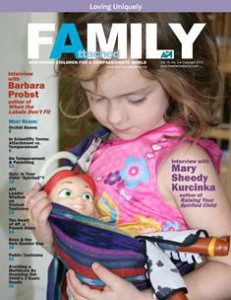By Bill Corbett, author of Love, Limits, & Lessons: A Parent’s Guide to Raising Cooperative Kids in English and in Spanish and member of the API Resource Advisory Committee, www.CooperativeKids.com.

Every January presents us with the opportunity for a fresh start, for doing things differently to make positive changes in our families’ lives. Here are my top 10 resolutions to help you engage in more peaceful parenting and create more joyful connection with your children this year.
1. Become aware of moments of frustration. Getting frustrated is a part of being human. When your child is not being cooperative or your children are engaging in sibling rivalry, it is easy to let your frustration flare up and control your next words or actions. Take notice of a moment of frustration and focus on how it feels. Pause, but don’t speak or act. Relax your entire body, and allow the frustration to pass before moving forward. This is a challenging skill, so give yourself credit for each time you are able to pause and reflect before acting.
2. See your child’s resistance as a wake-up call. When your child resists your requests, you may need to examine how you make them and your level of connection. Children crave power and being heard and seen in the family. When they are frequently told what to do, even gently, they begin to resist. Use his resistance as a “check in” on the relationship. Have you been spending enough quality time with him, in which you’ve been listening more than talking? Have you been allowing him age-appropriate autonomy so he can make decisions for himself?
3. Become more proactive instead of reactive. Setting rules and limits in advance is necessary for teaching children about boundaries, respect and safety. Rules and limits work best when established respectfully in advance, and engaging your child to help you in creating them motivates her to acknowledge them and follow through. Keeping limits and boundaries in place may require posting them for all to see and reviewing them frequently, but don’t overdo it.
4. Speak respectfully of the child’s other parent. We all hope our children will grow up to become people of integrity, and they’re more likely to do so if we give them a model to learn from. Whether you’re separated, going through a divorce, or just mad at your spouse, commit to always speaking respectfully about that other parent in the presence of your child. Your child still sees your partner as his parent, regardless of the issue you may have with that other adult.
5. Make more emotional deposits than withdrawals. In his book The 7 Habits of Highly Effective Families, author Stephen R. Covey urges parents to make more deposits than withdrawals in their children’s emotional bank accounts. The result will be greater cooperation and less undesirable behavior. Examples of deposits include encouraging words, acts of kindness and demonstrations of love. What deposits have you made in your children’s emotional bank accounts this past month?
6. See your child as good and not bad. Children are not “bad.” Instead, they may have “learned behaviors” that can be difficult to deal with. The behaviors can be coping skills or an attempt to meet needs. A few changes in a parent’s discipline toolbox can make all the difference in the world. Don’t be angry with your child; be patient, kind and open to learning.
7. Find ways to acknowledge and encourage your child. We’re so good at noticing and confronting misbehavior, but offering encouragement is far more powerful. Unfortunately, when our children are behaving as we’d like, we allow our attention to focus on the other stressful things we have to do in our adult life. Slow down and begin looking for opportunities to make positive observations to your children. Say to her, “It looks like you are having a lot of fun playing with your sister!” or “Thank you for helping your brother build that block tower.”
8. See if a “misbehavior” in your child is a desire to meet a need. Take a closer look at behaviors–they may actually be needs in disguise. A mother noticed that her little son was drawing on walls and other surfaces more and more. She tried every discipline technique she could, but his drawings continued. Finally, she went out and purchased a drawing easel and a colorful set of markers and crayons. The boy began to draw amazing pictures on his easel pad and no longer defaced other surfaces.
Challenging behavior may signal that your child needs more of your loving attention in the moment, especially if you’ve been busy doing your own work for a while. Taking a break from your tasks in order to spend some time with your child (one-on-one when possible) will help meet needs for attention and connection.
9. Give your child advance notices of a transition. Younger children live only in the moment and have great difficulty seeing beyond NOW. Because of that, they don’t transition well without advance warnings. Visual timers and visual schedules are incredibly effective at helping children to transition because they enable the child to see how much time is passing and the activities that are planned next.
If you don’t have a visual reminder handy in a given moment, a countdown of verbal reminders is also helpful. Be mindful of starting a countdown and then becoming distracted yourself with talking to another adult or doing another activity. A helpful long-term approach is to narrate your own thought process, since kids learn from what we model: “Oh, look at the time, we’d better start cleaning up … Ok, we should be leaving in 5 minutes, that’s time for two more trips down the slide, then we pack up the car … ”
10. Help your child move closer to his or her purpose in life. Effective parenting means more than just trying to get through each day, but also helping our children to hear the voice inside of them that guides them to find their purpose in life. Minimize the “noise” around her so she will hear and follow that voice over her lifetime.








